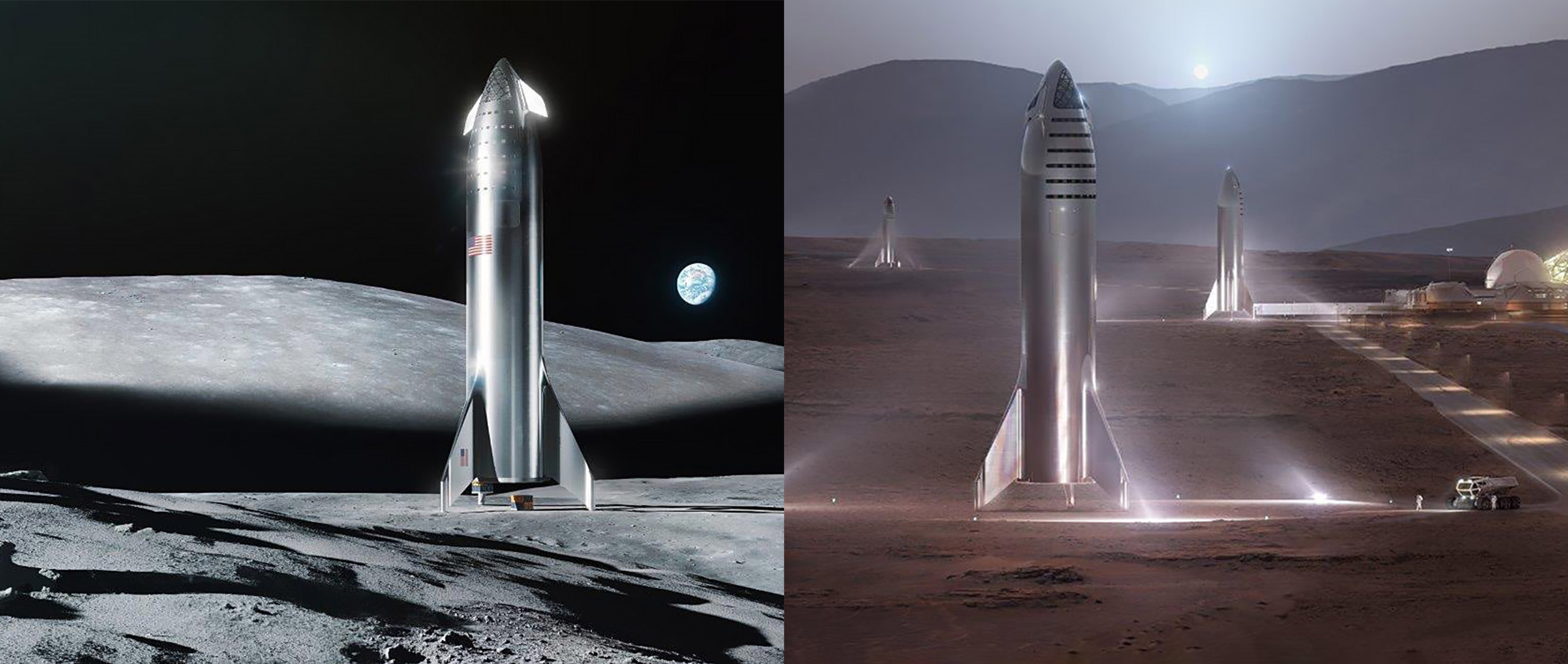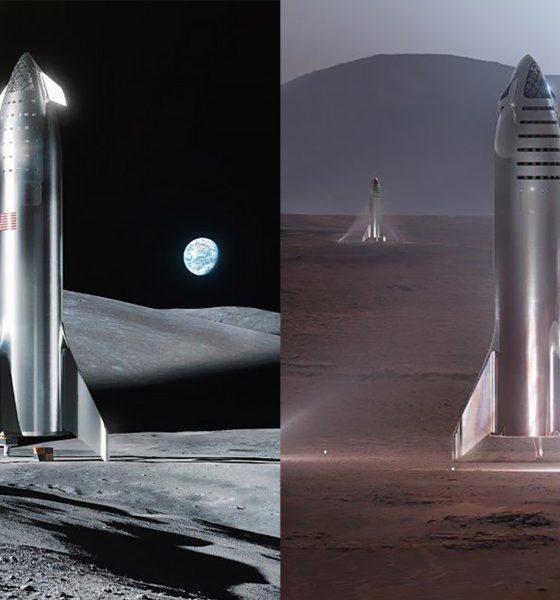

News
SpaceX CEO Elon Musk teases steel Starship on the Moon and Mars
SpaceX CEO Elon Musk has published the first official renders of the company’s updated stainless steel Starship, offering glimpses of the spacecraft on both the Moon and Mars.
Although the designs of Starship and Super Heavy (formerly BFS and BFR) have shifted significantly over the past three years, the vehicle’s primary destinations have remained stable. Above all else, SpaceX remains focused on designing its next-gen rocket to be the best spacecraft ever built for transporting huge payloads and humans to the Moon, Mars, and ultimately throughout the solar system. The interplanetary future of Starship is currently an unknown quantity but SpaceX is already building the first full-scale orbital prototype and testing multiple finished versions of the Raptor engine that will power it.
As discussed earlier today, SpaceX has already completed a low-fidelity prototype of Starship known as Starhopper, designed to – per its namesake – perform low-altitude, low-velocity hop tests. Powered by Raptor, Starhopper also acts as a mobile test stand for the next-gen rocket engine meant to power both Starship and its Super Heavy booster. SpaceX’s current planning has delayed a vacuum variant of the engine for several years, instead choosing to standardize the same Raptor engine across both stages of BFR. Starship will feature seven Raptor engines producing ~14,000 kN (~3.2M lbf) of thrust, while Super Heavy’s latest iteration would require a 31 Raptors and produce a staggering 62,000 kN/14M lbf of thrust at liftoff.
That performance – theoretically making Starship/Super Heavy almost two times as powerful as Saturn V – is essential to support massive missions to Mars and the Moon while also enabling complete reusability of the rocket. SpaceX rightly judged that rapid, low-effort reusability is the only way to truly revolutionize the cost of access to orbit, at least for the indefinite future. This need itself piggybacks on CEO Elon Musk’s founding motivation: to make humanity a multi-planetary species and protect it against future mass-extinction events.
Musk has long viewed the Moon as a distraction to that goal, offering very little prospect of being more than a detour, but both NASA and the political apparatus currently controlling the US have decided that a rebranded Moon return is desirable. Repeating several nearly identical Moon return proposals from the last few decades, the political powers that be have yet to actually put any money where their mouths are. SpaceX and Musk have nonetheless jumped on the bandwagon, a pragmatic decision to hedge bets in case funding actually appears. Unsurprisingly, SpaceX is interested in any opportunity to acquire federal funding for its expensive Starship/Super Heavy/Raptor development programs.
In September 2018, SpaceX announced plans to send Japanese billionaire Yusaku Maezawa and 8-10 artists of his choice on the first Starship mission around the Moon. According to Musk, that could happen as early as 2023 but will necessarily be preceded by at least one uncrewed demonstration of Starship’s performance in deep space. Given the nominal reusability of Starship, the same spacecraft might perform both missions.
In the meantime, SpaceX is in the process of building the first orbital Starship prototype, although it’s unclear just how advanced the vehicle will be. Depending on how polished and successful SpaceX’s Starship Alpha (for lack of a better term) is, it’s conceivable that the spacecraft could be retrofitted or upgraded for actual demonstration missions to deep space or the Moon. To enable the long-term reusability of Starships, SpaceX will need to rely on in-orbit refueling by way of dedicated tanker launches. However, a lower-fidelity prototype that might otherwise be scrapped could be a prime candidate for a one-way Moon-impact or lunar-landing mission, reducing risk for future crewed or uncrewed Starship missions to the Moon before SpaceX has the facilities and hardware to support simultaneous Starship and tanker launches.
Check out Teslarati’s Marketplace! We offer Tesla accessories, including for the Tesla Cybertruck and Tesla Model 3.

News
Tesla FSD fleet is nearing 7 billion total miles, including 2.5 billion city miles
As can be seen on Tesla’s official FSD webpage, vehicles equipped with the system have now navigated over 6.99 billion miles.

Tesla’s Full Self-Driving (Supervised) fleet is closing in on almost 7 billion total miles driven, as per data posted by the company on its official FSD webpage.
These figures hint at the massive scale of data fueling Tesla’s rapid FSD improvements, which have been quite notable as of late.
FSD mileage milestones
As can be seen on Tesla’s official FSD webpage, vehicles equipped with the system have now navigated over 6.99 billion miles. Tesla owner and avid FSD tester Whole Mars Catalog also shared a screenshot indicating that from the nearly 7 billion miles traveled by the FSD fleet, more than 2.5 billion miles were driven inside cities.
City miles are particularly valuable for complex urban scenarios like unprotected turns, pedestrian interactions, and traffic lights. This is also the difference-maker for FSD, as only complex solutions, such as Waymo’s self-driving taxis, operate similarly on inner-city streets. And even then, incidents such as the San Francisco blackouts have proven challenging for sensor-rich vehicles like Waymos.
Tesla’s data edge
Tesla has a number of advantages in the autonomous vehicle sector, one of which is the size of its fleet and the number of vehicles training FSD on real-world roads. Tesla’s nearly 7 billion FSD miles then allow the company to roll out updates that make its vehicles behave like they are being driven by experienced drivers, even if they are operating on their own.
So notable are Tesla’s improvements to FSD that NVIDIA Director of Robotics Jim Fan, after experiencing FSD v14, noted that the system is the first AI that passes what he described as a “Physical Turing Test.”
“Despite knowing exactly how robot learning works, I still find it magical watching the steering wheel turn by itself. First it feels surreal, next it becomes routine. Then, like the smartphone, taking it away actively hurts. This is how humanity gets rewired and glued to god-like technologies,” Fan wrote in a post on X.
News
Tesla starts showing how FSD will change lives in Europe
Local officials tested the system on narrow country roads and were impressed by FSD’s smooth, human-like driving, with some calling the service a game-changer for everyday life in areas that are far from urban centers.

Tesla has launched Europe’s first public shuttle service using Full Self-Driving (Supervised) in the rural Eifelkreis Bitburg-Prüm region of Germany, demonstrating how the technology can restore independence and mobility for people who struggle with limited transport options.
Local officials tested the system on narrow country roads and were impressed by FSD’s smooth, human-like driving, with some calling the service a game-changer for everyday life in areas that are far from urban centers.
Officials see real impact on rural residents
Arzfeld Mayor Johannes Kuhl and District Administrator Andreas Kruppert personally tested the Tesla shuttle service. This allowed them to see just how well FSD navigated winding lanes and rural roads confidently. Kruppert said, “Autonomous driving sounds like science fiction to many, but we simply see here that it works totally well in rural regions too.” Kuhl, for his part, also noted that FSD “feels like a very experienced driver.”
The pilot complements the area’s “Citizen Bus” program, which provides on-demand rides for elderly residents who can no longer drive themselves. Tesla Europe shared a video of a demonstration of the service, highlighting how FSD gives people their freedom back, even in places where public transport is not as prevalent.
What the Ministry for Economic Affairs and Transport says
Rhineland-Palatinate’s Minister Daniela Schmitt supported the project, praising the collaboration that made this “first of its kind in Europe” possible. As per the ministry, the rural rollout for the service shows FSD’s potential beyond major cities, and it delivers tangible benefits like grocery runs, doctor visits, and social connections for isolated residents.
“Reliable and flexible mobility is especially vital in rural areas. With the launch of a shuttle service using self-driving vehicles (FSD supervised) by Tesla in the Eifelkreis Bitburg-Prüm, an innovative pilot project is now getting underway that complements local community bus services. It is the first project of its kind in Europe.
“The result is a real gain for rural mobility: greater accessibility, more flexibility and tangible benefits for everyday life. A strong signal for innovation, cooperation and future-oriented mobility beyond urban centers,” the ministry wrote in a LinkedIn post.
News
Tesla China quietly posts Robotaxi-related job listing
Tesla China is currently seeking a Low Voltage Electrical Engineer to work on circuit board design for the company’s autonomous vehicles.

Tesla has posted a new job listing in Shanghai explicitly tied to its Robotaxi program, fueling speculation that the company is preparing to launch its dedicated autonomous ride-hailing service in China.
As noted in the listing, Tesla China is currently seeking a Low Voltage Electrical Engineer to work on circuit board design for the company’s autonomous vehicles.
Robotaxi-specific role
The listing, which was shared on social media platform X by industry watcher @tslaming, suggested that Tesla China is looking to fill the role urgently. The job listing itself specifically mentions that the person hired for the role will be working on the Low Voltage Hardware team, which would design the circuit boards that would serve as the nervous system of the Robotaxi.
Key tasks for the role, as indicated in the job listing, include collaboration with PCB layout, firmware, mechanical, program management, and validation teams, among other responsibilities. The role is based in Shanghai.
China Robotaxi launch
China represents a massive potential market for robotaxis, with its dense urban centers and supportive policies in select cities. Tesla has limited permission to roll out FSD in the country, though despite this, its vehicles have been hailed as among the best in the market when it comes to autonomous features. So far, at least, it appears that China supports Tesla’s FSD and Robotaxi rollout.
This was hinted at in November, when Tesla brought the Cybercab to the 8th China International Import Expo (CIIE) in Shanghai, marking the first time that the autonomous two-seater was brought to the Asia-Pacific region. The vehicle, despite not having a release date in China, received a significant amount of interest among the event’s attendees.








